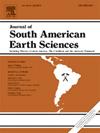Tectonic geomorphology of mountain relief in the northeast of Mexico. Example of the Santa Rosa, Obayos and Pájaros Azules ranges
IF 1.7
4区 地球科学
Q3 GEOSCIENCES, MULTIDISCIPLINARY
引用次数: 0
Abstract
A tectonic geomorphology analysis was carried out in the Santa Rosa, Obayos and Pájaros Azules ranges, with the aim of delving deeper into the regional geological characteristics of northeastern Mexico. The digital processing and interpretation of morphometric maps and geomorphic indices derived from a digital elevation model (DEM) at a scale of 1:50,000 was carried out. Hypsometric, surface drainage, slope, roughness, vertical dissection (VD), isobase, channel gradient and mountain-front sinuosity index maps were interpreted. The analysis reveals, in the Obayos and Pájaros Azules ranges, the development of internal valleys with fluvial drainage to the NE, parallel to the axis of the homonymous anticlines. The Santa Rosa range has a higher altitude and gradient than Obayos and Pájaros Azules. According to the 2nd- and 3rd-order isobases, the Santa Rosa range has higher altitudes (1485 m and 1539 m) than Pájaros Azules (1476 m and 878 m) and Obayos (1163 m and 1085 m), respectively. Morphoalignments with NE-SW directions were identified that are arranged transversely to the axes of the anticlines that form the ranges. In the Santa Rosa SE area, the morphoalignments are radial and coincide with basaltic outcrops; this suggests extensional processes due to the flexure of the anticline axis, which generated fissures and caused the ascent of igneous material. The relief in the Obayos and Pájaros Azules ranges is more evolved, due to a greater structural uplift and denudation. In contrast, the Santa Rosa range exhibits a younger relief. The sinuosity index of the mountain front indicates that the three mountain ranges present a moderate level of tectonic activity, with the Obayos mountain range having the lowest Smf value (1.65) and the greatest tectonic activity. These morphotectonic findings show the relationship between regional tectonic evolution and morphogenic processes in NE Mexico.
墨西哥东北部山地地形的构造地貌。例如Santa Rosa, Obayos和Pájaros Azules系列
为了深入研究墨西哥东北部的区域地质特征,在Santa Rosa、Obayos和Pájaros Azules山脉进行了构造地貌分析。对1:5万比例尺数字高程模型(DEM)生成的地貌测量图和地貌指数进行了数字化处理和解译。对坡度图、地表水系图、坡度图、粗糙度图、垂直解剖图、等底图、河道坡度图和山前曲度指数图进行了解译。分析表明,在Obayos和Pájaros Azules山脉,河流向北流的内部山谷发育,平行于同名背斜的轴线。圣罗莎山脉的海拔和坡度都高于奥巴约斯山脉和Pájaros Azules山脉。根据二阶和三阶等碱基,Santa Rosa山脉的海拔高度(1485 m和1539 m)分别高于Pájaros Azules (1476 m和878 m)和Obayos (1163 m和1085 m)。确定了与形成山脉的背斜轴线横向排列的NE-SW方向的形态排列。在Santa Rosa SE地区,形态排列呈放射状,与玄武岩露头重合;这表明由于背斜轴的弯曲而引起的伸展作用产生了裂缝并引起了火成岩物质的上升。由于较大的构造隆升和剥蚀作用,Obayos和Pájaros Azules山脉的地形更为演化。相比之下,圣罗莎山脉呈现出较年轻的地形。山锋弯曲度指数表明,3个山脉的构造活动处于中等水平,其中奥巴约斯山脉的Smf值最低(1.65),构造活动最大。这些形态构造发现揭示了墨西哥东北部区域构造演化与形态形成过程之间的关系。
本文章由计算机程序翻译,如有差异,请以英文原文为准。
求助全文
约1分钟内获得全文
求助全文
来源期刊

Journal of South American Earth Sciences
地学-地球科学综合
CiteScore
3.70
自引率
22.20%
发文量
364
审稿时长
6-12 weeks
期刊介绍:
Papers must have a regional appeal and should present work of more than local significance. Research papers dealing with the regional geology of South American cratons and mobile belts, within the following research fields:
-Economic geology, metallogenesis and hydrocarbon genesis and reservoirs.
-Geophysics, geochemistry, volcanology, igneous and metamorphic petrology.
-Tectonics, neo- and seismotectonics and geodynamic modeling.
-Geomorphology, geological hazards, environmental geology, climate change in America and Antarctica, and soil research.
-Stratigraphy, sedimentology, structure and basin evolution.
-Paleontology, paleoecology, paleoclimatology and Quaternary geology.
New developments in already established regional projects and new initiatives dealing with the geology of the continent will be summarized and presented on a regular basis. Short notes, discussions, book reviews and conference and workshop reports will also be included when relevant.
 求助内容:
求助内容: 应助结果提醒方式:
应助结果提醒方式:


